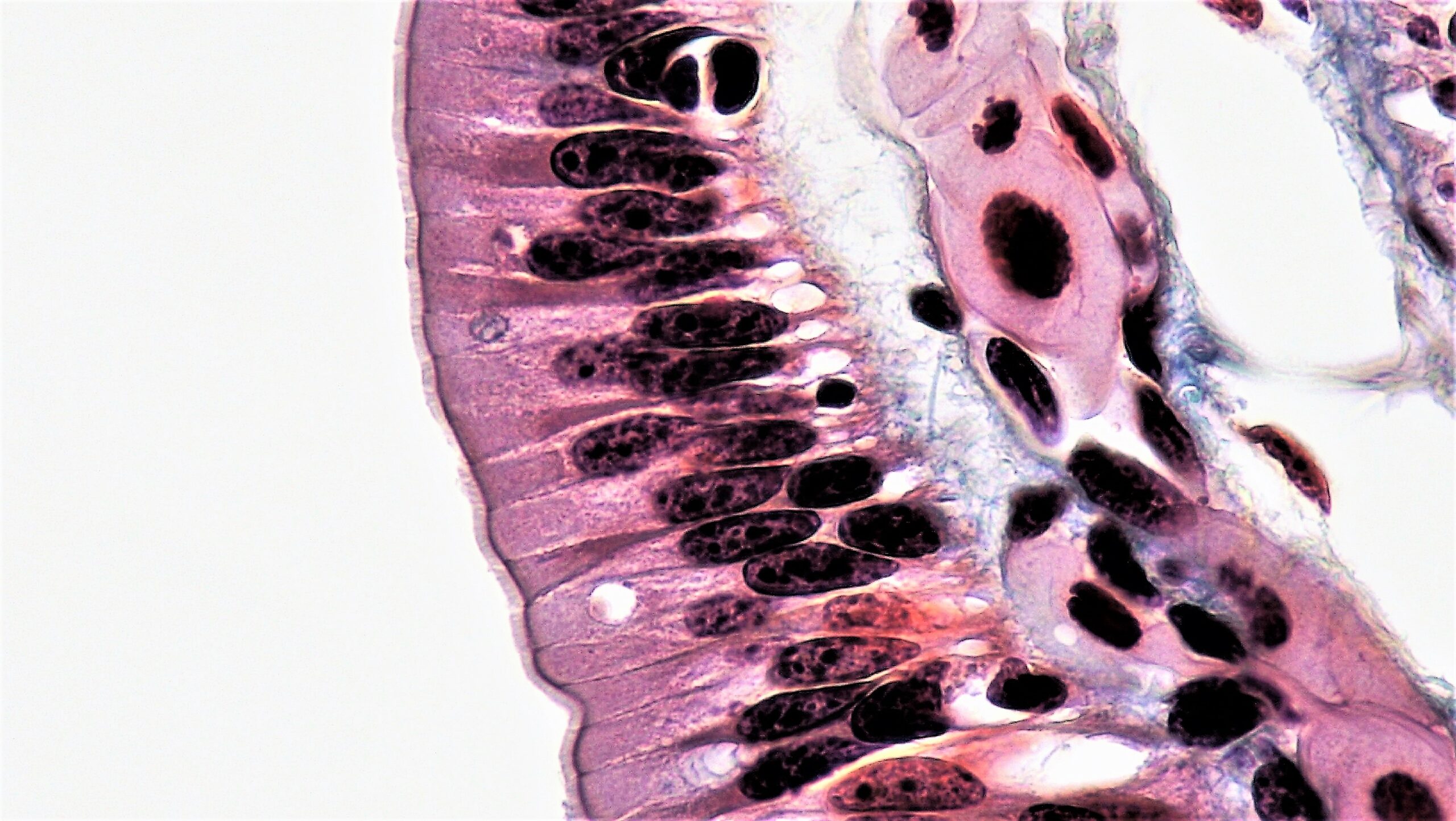Playlist
Show Playlist
Hide Playlist
Surface Modifications of Epithelial Cells
-
Slides 05 EpithelialTransport GeneralPhysiology.pdf
-
Download Lecture Overview
00:01 Epithelial and endothelial transport. 00:04 How we’re going to get molecules both across a cell, across a vessel, and across a tissue? This is going to be very helpful for reabsorption, absorption, and then also delivery of substances from the blood to various tissues. 00:24 The surface of epithelial tissue is very important. 00:29 It has a number of modifications that have been made to it to increase its likelihood to do a good job. 00:37 These apical membranes, and the apical membrane is the membrane closest to the tube. 00:44 This oftentimes has been modified to include more surface area and how it is included more surface area is by projections, things like villi and microvilli, even having more invaginations associated with the membrane allows for a greater surface area within a given volume. 01:06 The other way that there can be apical modifications is via cilia. 01:11 These sometimes will be motive in nature, meaning that they will want to help something move along like the mucociliary elevator in the respiratory tract, or sometimes it is sensory in nature like what is in the renal epithelial tissue in the distal convoluted tubule next to the macula densa. 01:33 The lateral aspects of epithelial tissue are as equally or maybe even more important. 01:41 It’s hard to think about the junctions between cells as being important. 01:46 They just seem like they are there to hold themselves together. 01:49 But this can be an important process to move solutes through various tissues. 01:56 They form something called tight junctions. 01:59 Tight junctions can either be tight or tighter and they have high electrical resistances and help you establish gradients across the epithelial tissue. 02:12 There are also leakier tight junctions and I know the wording is a little bit confusing here. 02:19 They are called tight junctions, but some tight junctions are not as tight as others, so we call those leakier. 02:27 The ones tight junctions that are tighter we call tighter. 02:31 So leakier tight junctions have a lower electrical resistance and they oftentimes are there to help isosmotic movement of fluids. 02:46 The lateral aspects also have some anchoring junctions. 02:50 Now, these are the ones to help hold it together. 02:53 They have cell-to-cell interactions, which involves these adhering junction and desmosomes, as well as having gap junctions. 03:04 Gap junctions help two cells communicate between each other across this distance of having both plasma membranes. 03:12 The basolateral membrane of epithelial surfaces also can have surface area enhancing structures such as invaginations or infoldings. 03:24 But they are very important to be able to hold tight to something else, usually, from the epithelial surface to another cell surface. 03:34 They use hemidesmosomes for this and focal adhesions. 03:38 Epithelial transport allows for multiple ways in which you’re going to get across that membrane surface. 03:47 You can either move between a cell by those lateral mechanisms and that’s known as paracellular flow, or you can move from the apical membrane to the basolateral membrane and that is called transcellular flow. 04:05 It is good to look at an example of these two types of flow. 04:09 Let’s look at the flow of water or fluid flow. 04:13 You could travel through an aquaporin in the apical membrane then travel through a second aquaporin in the basolateral membrane. 04:23 This would be a good example of a transcellular flow through aquaporins. 04:29 Another way to get water through from the apical membrane to the basolateral is between a cell, and this paracellular flow can happen in leakier tight junctions. 04:47 Epithelial cells also need to be thought of as having two different polar ends. 04:54 How we will discuss this is first talk about a symmetrical cell that has transporters all the way through that cell. 05:03 And in this case you might have things like potassium channels, sodium channels, and a sodium-potassium ATPase. 05:11 They are located throughout the cell or around that cell. 05:16 In contrast, epithelial cells have their transporters polarized. 05:24 So, you will have the sodium-potassium ATPases on the basolateral membrane. 05:31 You might have some channels like potassium channels also on the basolateral membrane. 05:37 But then you’ll have specialized channels maybe at the top, like these sodium channels. 05:42 So you concentrate your channels on different sides of the membrane. 05:47 This allows for the transport to occur from the apical membrane into the cell and then out on the basolateral membrane. 05:57 So this is a good example to think about where the transporters are. 06:06 If you have transporters that are like epithelial on one side versus the other, it creates something called vector transport and this is moving something across a cell layer. 06:21 So where would you want to move something across a cell layer? Well, here, it might be to transport, let’s say, food stuff from the gut or from the GI’s tract across enterocytes into the interstitial fluid to be picked up by the blood. 06:40 You also sometimes generate voltage differences across the epithelial cell because some of the transporters are located on one side and a different set is on the other. 06:53 Sometimes they won’t transport things at the same rate or maybe certain ions cross that are either positive or negative, and that sets up a gradient of positive and negative charges. 07:08 Remember, voltage differences are very important and they are set up by these ion concentration differences.
About the Lecture
The lecture Surface Modifications of Epithelial Cells by Thad Wilson, PhD is from the course Membrane Physiology.
Included Quiz Questions
Which sites of the epithelial membrane most likely contains Na-K ATPase?
- Basolateral
- Apical
- Luminal
- At the base of microvilli
- Within tight junctions
In which of the following locations are villi and microvilli found?
- Apical membrane of the enterocyte
- Lateral surface of the entrocyte
- Basal surface of the enterocyte
- Near the desmosomes
- Near the tight junctions
Which of the following condition would make the tight junctions tighter?
- If they have a greater electrical resistance and establish ionic gradients.
- If they have a lower electrical resistance
- If they are iso-osmotic.
- If they contain actin.
- If they contain gap junctions.
Which of the following statements is TRUE regarding gap junctions?
- They help cells communicate with each other.
- They provide stability between cells.
- They provide ion exchange between cells.
- They stabilize voltage between cells.
Which of the following statements best describe leakier tight junctions?
- They allow passage of water or solutes via a paracellular flow.
- They allow passage of solutes only via a transcellular flow.
- They do not allow passage of water or solutes.
- They allow passage of water only via a transcellular flow.
Which of the following statements best describe the cell membranes of enterocytes?
- They are polarized.
- They possess an equal distribution of ion channels.
- They possess more sodium ion channels on the basolateral membrane.
- They possess Na/K ATPases on the luminal side of the membrane.
- They are devoid of gap junctions.
Which of the following statements best describe desmosomes?
- They anchor the cells to one another.
- They anchor the cell to the extracellular matrix.
- They anchor iso-osmotic passage of fluids.
- They require energy for transport.
- They are contained entirely in one cell.
Which of the following statements best describe vector transport across an intestinal epithelial cell?
- The cell utilizes voltage differences between the apical and basolateral sides to transport solutes from the lumen to the blood.
- The cell utilizes tight junctions between the apical and basolateral sides to transport solutes from the lumen to the blood.
- The cell utilizes Na/K ATPases located on the apical side to transport solutes from the lumen to the blood.
- The cell utilizes sodium concentration differences between the apical and basolateral sides to transport solutes from the lumen to the blood.
- The cell utilizes osmotic differences between the apical and basolateral sides to transport solutes from the lumen to the blood.
Customer reviews
4,0 of 5 stars
| 5 Stars |
|
0 |
| 4 Stars |
|
1 |
| 3 Stars |
|
0 |
| 2 Stars |
|
0 |
| 1 Star |
|
0 |
Excellently Explained about the transport and clarifies doubts regarding the different transport modes in membranes




